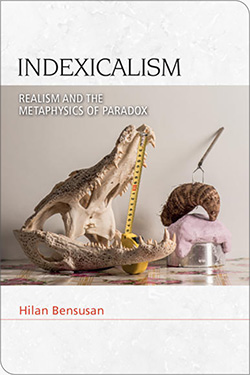
Graham Harman and Hilan Bensusan
Have you read Part 1 and 2?
Part 1
Part 2
Graham Harman: Let’s turn now to your relation with a relevant analytic philosopher, Saul Kripke. In recent decades Kripke has been widely read among continental philosophers for his employment of “direct reference” by means of proper names or rigid designators[i]. What do you take from Kripke, and what do you reject or at least modify?
Hilan Bensusan: The idea of direct reference has always appeared to me as compelling, or at least enlightening. To me, the central element of Kripke’s way of approaching the relation between thought and its content is the idea that fixing a reference is to be distinguished from satisfying a description or stating a necessary (a priori) truth. There is a linguistic contact that is made between ‘cat,’ say, and its referent no matter whether cats are animals or robots. Through this linguistic contact, an expression is like a photo (in Gareth Evans’ apt metaphor), for it matters little what the image looks like– Yeltsin could look like Trump in a photo, but it is still a photo of Yeltsin[ii].
Interestingly, contact through direct reference circumvents not only description but any kind of representational cognition. This is the great move made by Kripke: he doesn’t need to commit to any dodgy epistemological notions such as ‘acquaintance’; direct reference is not an epistemological item. As a consequence, reference can be thought of as (relatively) independent of epistemology, as Howard Wettstein often insisted, and semantic content is no longer to be thought as in the head[iii]. Externalism is an interesting idea brought forward by direct reference and has a salient family resemblance with externalism towards cognitive justification. The idea that semantic properties are part of the furniture of the universe through linguistic contact and epistemic properties pave sthe way to new forms of realism.
Indexicalism draws from the work of David Kaplan and John Perry about demonstratives and essential indexicals[iv]. Kaplan understands a demonstrative to refer directly to an object in the world through its character, which is resolved into its content (the object) through context. Perry argues that this semantic story undermines the indexical poison carried by demonstratives: they cannot be resolved into (substantive) individuals. Perry argues that language and thought are far more implicitly indexical than it is ordinarily assumed. My own theory of indexicalism takes this a step further to argue that reality itself is implicitly indexical. We can formulate this theory by saying that by fixing a reference one points at something (let’s call it an ‘address’) and that is the ultimate furniture of the universe. That is, the world is composed of addresses that are directly referred to and that are independent of whether cats are robots or animals. The idea of a direct reference to an address ensures that indexicalism is thoroughly externalist and realist.

Kripke would favor an approach to complex demonstratives like ‘this table’, entailing that in a different world this table could be broken, could be painted with a different color, and could have been cut in a different shape, but to be this table it has to share the same (substantive) origin. Kripke’s account is far from indexicalism, in the sense that he seems to favor something like a (substantive) essence that ensured that this table was not made of different material in any possible world. Indexicalism would rather bring together Kripke’s notion of possible worlds (and the possibility of trans-world identity) and an account of direct reference where addresses are the protagonists. In this sense, my theory expands Kripke’s views on direct reference with the help of Kaplan’s logic of demonstratives and Perry’s implicit indexicality. It goes further by assuming that reference-fixing is a path to a complex realism about deixis.
In any case, direct reference posits that denotata are more than whatever any description of them can provide. In that sense, it can be directly compared with Levinas’ insistence that the Other cannot be fully encapsulated by descriptions. Clearly, there are important differences between Levinas’ resistance to encompassing descriptions and the issues around direct reference. However, there is a common gesture that affirms what is exterior and attempts to do justice to what is unreachable by descriptions.
Graham Harman: A great deal of modern philosophy, I would even say most of it, begins with a duality of human thought on one side and a world outside thought on the other, which I like to call “onto-taxonomy.”[v] A great deal of time is spent debating whether it is easy or difficult for thought to gain access to the world, and if it is difficult, then how exactly we go about doing it. By contrast, you jump straight to a meditation on the world itself, in a way that often reminds me of Whitehead more than any other philosopher since Kant. But how would you deal with the threat of an “enclosure paradox,” to use the term Jon Cogburn draws from the work of Graham Priest?[vi] In other words, what do you say in response to someone who claims that indexicalism cannot get beyond the subjective standpoint and therefore simply remains another form of what Meillassoux calls “correlationism”?[vii]
Hilan Bensusan: Correlationism can be portrayed as an anti-realism, or perhaps merely as a skepticism, about the Great Outdoors. In thinking or merely in knowing, we are confined,to our correlations with what is out there and cannot reach what is absolute. Indexicalism responds to this by recommending a realism about the Great Outdoors and about the outside, the exterior, the other. It is a way to take the Great Outdoors as what it is, a disrupting limit that ought to have an impact on what is thought or known, even though it cannot be fully converted into content of what is thought or known. The Great Outdoors, which is a figure of the metaphysics of the others, leaves its traces in thinking and knowing –haunts them– and precisely because the exterior is irreducibly exterior. The exterior is thought through from inside and it is from the inside that it has to be exterior. Otherwise, something else is going to be exterior given any indexically mapped position. This is akin to what Levinas called the ontological argument in favor of the Other.
In Meillassoux’s terminology concerning the age of the correlate, indexicalism is not strong correlationism because exteriority as such is thought through in indexical terms. It is not weak correlationism –the thesis that we cannot know anything but correlations even though something else can be thought through– because we can know the exterior as exterior even if it is never fully transparent. The others are not fully known in their indexical structure but they are taken as others and leave traces on what is known (at least because each position has an inside and an outside). Perhaps indexicalism is then some sort of metaphysics of subjectivity, the term that Meillassoux borrowed from Heidegger: or “subjectalism,” as he subsequently decided to call these positions[viii]. Indexicalism holds that there are deictic absolutes, but these absolutes are not correlations precisely because they involve the others, the outdoors, the exterior. Its Whiteheadian ingredient places it in the middle of things with no privilege granted to the human subject, while its Levinasian component makes sure that exteriority is taken seriously. There is still maybe a fear that deictic absolutes will end up being no more than phenomena and that there are things-in-themselves that are not accessible (neither knowable nor even thinkable). But this is only possible if a substantive –and not indexical– subject is conceived in such a way that deixis will merely be things-for-this-(substantive)-subject. If this subject is positioned, it will have a horizon and therefore an exterior. Indexicalism and the metaphysics of the others recommend a strong realism about the Great Outdoors and diagnose the opponents of such realism as engaging in some form of substantivism according to which situatedness is explicitly or tacitly abandoned.
Read on…
Parts 4 in A Conversation with Graham Harman and Hilan Bensusan on ‘Indexicalism‘
Get your copy of Indexicalism here
Proposes a radical new metaphysics where reality is not substantive but is indexical
- Puts forward a new theory of metaphysics where the furniture of the universe is deictic and substantives are conceived as thoroughly situate
- Extends the idea of metaphysics as transcendence, proposed by Levinas, to a process philosophy where the Other is not only human but ultimately the Great Outdoors
- Presents an approach to perception that makes it close to a conversation which portrays conceptual mediation as a special case of the Whiteheadian notion of importance
About the speakers…
Graham Harman is Distinguished University Professor of Philosophy at Southern California Institute of Architecture (on leave from the American University in Cairo). His previous books include Tool-Being (2002), Guerrilla Metaphysics (2005), Heidegger Explained (2007), Prince of Networks (2009), Towards Speculative Realism (2010), Circus Philosophicus (2010), L’Objet quadruple (2010), and The Prince and the Wolf [with Bruno Latour and Peter Erdélyi] (2011).
Hilan Bensusan is Professor of Contemporary Philosophy at the University of Brasilia. He is the author of Being Up for Grabs: On Speculative Anarcheology (Open Humanities Press, 2016). His other books are published in Portuguese: A diáspora da agência – Ensaio sobre o horizonte das monadologias (The diaspora of agency – Essay on the horizon of monadologies) (EdUFBA, 2018), Linhas de animismo futuro (Lines of future animism) (Mil Saberes, 2017), Heráclito – Exercícios de Anarqueologia (Heraclitus – Exercises in anarcheology) (Ideias e Letras, 2012) and Excessos e Exceções (Excesses and exceptions) (Ideias e Letras, 2008).
[i] Saul Kripke, Naming and Necessity. (Cambridge, MA: Harvard University Press, 1972.)
[ii] Gareth Evans, Collected Papers. (Oxford: Oxford University Press, 1985.)
[iii] Howard Wettstein, The Magic Prism: An Essay in the Philosophy of Language. (Oxford: Oxford University Press, 2007.)
[iv] David Kaplan, “Demonstratives,” in Themes from Kaplan, ed. J. Almog et al., pp. 481-563. (Oxford: Oxford University Press, 1989); John Perry, “The Problem of the Essential Indexical,” Noûs, 13.1 (1979), pp. 3-21.
[v] See Graham Harman, Dante’s Broken Hammer: The Ethics, Aesthetics, and Metpahyics of Love, p. 237. (London: Repeater, 2016); Graham Harman, “The Only Exit from Modern Philosophy,” Open Philosophy 3.1 (2020), pp. 132-146; Niki Young, “Only Two Peas in a Pod: On the Overcoming of Ontological Taxonomies,” Symposia Melitensia, vol. 17 (2021), 27-36.
[vi] Graham Priest, Beyond the Limits of Thought, Second Edition. (Oxford: Clarendon Press, 2003.)
[vii] Quentin Meillassoux, After Finitude: An Essay on the Necessity of Contingency, trans. R. Brassier. (London: Continuum, 2008.)
[viii] Quentin Meillassoux, “Iteration, Reiteration, Repetition: A Speculative Analysis of the Sign Devoid of Meaning,” trans. R. Mackay & M. Gansen, in Genealogies of Speculation: Materialism and Subjectivity Since Structuralism, eds. A. Avanessian & S. Malik, pp. 117-197. (London: Bloomsbury, 2016.)






